Hand Gestures in Art: Mudrâs
A couple of days ago while I was crossing the street—with the walk light on—some dope decided he didn’t want to wait for a green light and drove through the red, across my path, not three feet in front of me. As he passed me he gave me a certain hand gesture, why I don’t know. I thought, “Geez, and I had the walk light!” Well, the hand gesture was a definite negative. And you know what this art historian does with a negative? He turns it into a positive art history story!
Ever since I first studied Asian art in college, I’ve been fascinated by the hand gestures carved or painted on images of Buddha or bodhisattvas. This tradition goes way back to the very first known carved images of the Buddha from northern India/Pakistan. This is an early example of the abhaya mudrâ.
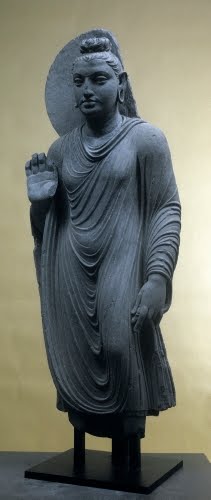 |
| Pakistan, Buddha Sakyamuni, from Peshawar, Gandhara, ca. 150–200 CE. Schist, height: 47 1/8" (119.7 cm). © Cleveland Museum of Art. (CL-206) |
Representations of the Buddha and bodhisattvas are almost always shown with their hands making certain gestures. These gestures have been ritualized and stylized down through the history of Buddhist art. These stylized gestures have symbolic meaning relating to the Buddha’s ministry, and are known as mudrâs. Mudrâ comes from the Sanskrit root mud, which means "to delight in." They are a traditional part of classic Indian dance, Yoga, and spiritual practices. Representations of some aspects of the Buddha require a certain mudrâ, and some require specific objects to be held.
Harina and Avakasha mudras:
The harina, or “lion gesture,” is always shown on the right hand. It is meant to symbolize peace and protection. The avakasha is a left hand gesture of leisure. Bodhisattvas are generally saints, people who have achieved enlightenment but forsake Nirvana to remain with humans to help them find their way. Arhats are considered “perfected people” who have found Nirvana.
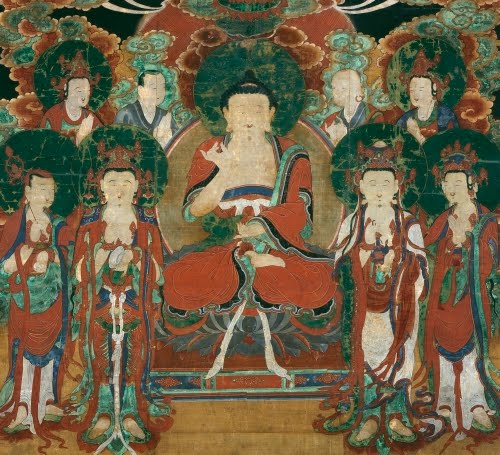 |
| Korea, Amithaba with Six Bodhisattvas and Two Arhats, 1700s. Ink and colors on silk, 31 7/8" x 35 3/8" (81 x 90 cm). © Brooklyn Museum. (BMA-656) |
Cincihna:
Cincihna, the “gesture of understanding,” is a right-handed gesture. It symbolizes understanding in the sense of spiritual understanding. Guanyin is one of the most popular of the bodhisattvas. He is considered the bodhisattva of compassion. In this sculpture, he sits in the “position of royal ease.”
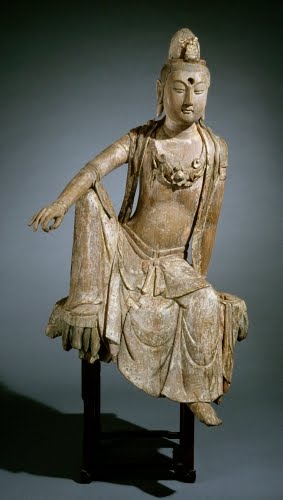 |
| China, Bodhisattva Guanyin, 1279–1368. Wood, height: 50 3/8" (128 cm). © Philadelphia Museum of Art. (PMA-1890) |
Bhumisparsha and avakasha:
Bhumisparsha, always the right hand, is the “gesture of witness.” It pertains to the time when Mara—the demon, or, symbolically the sum of blind passions in humans that keeps them from enlightenment—tried to obstruct Buddha from obtaining enlightenment while he was meditating under the Pippala tree. He basically threw obstructions and temptations at the Buddha, finally challenging him to provide proof of his virtues. Buddha touch the ground and the goddess of the Earth gave witness to his virtues. The leisure gesture shows how unperturbed the Buddha was with Mara’s machinations.
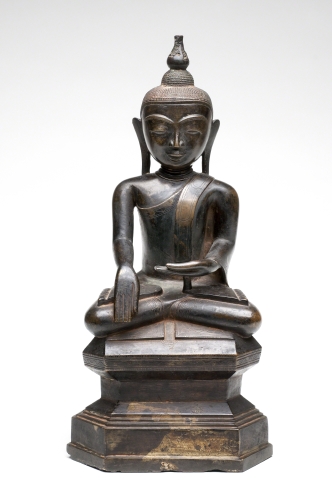 |
| Myanmar, Seated Buddha, 1700s–1800s. Bronze, 15 3/4" x 6 1/2" x 5 1/4" (40 x 16.5 x 13.3 cm). © Philadelphia Museum of Art. (PMA-6655) |
Dhyana:
This is the “gesture of meditation,” sometimes called Samadhi or Yoga mudrâ. It is commonly used for images of the Buddha Sakyamuni (“sage of the Sakyas”, Buddha’s clan), Buddha Amitabha (the Buddha of “Infinite Life,” connected with Pure Land Buddhism), and Medicine Buddha (fully enlightened human, healer of outer and inner sickness). Kannon is the Japanese translation of Guanyin. In depictions of Guanyin, the meditation gesture emphasizes his capacity to help humans achieve enlightenment through perfected meditation.
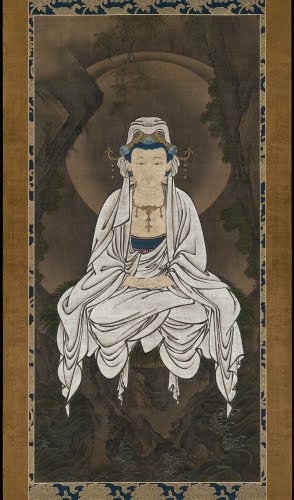 |
| Kanō Motonobu (1476–1559, Japan), Bodhisattva of Compassion (Kannon/Guanyin). Ink, color and gold leaf on silk, hanging scroll, 61 7/8" x 30" (57.2 x 76.4 cm). © Museum of Fine Arts, Boston. (MFAB-783) |
Abhaya:
This is one of the oldest mudrâs seen in depictions of the Buddha. It is commonly associated as a “gesture of blessing,” “gesture of fearlessness,” or “gesture of protection.” It is sometimes depicted as a left-handed gesture. My professor in college said it literally indicates the Buddha expressing the idea of “have no fear.”
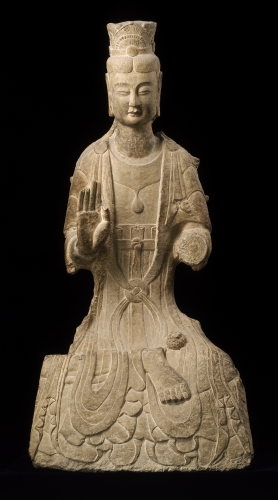 |
| China, Seated Bodhisattva, ca. 530 CE. Limestone, 77 3/8" x 35 7/16" x 18 1/8" (196.5 x 90 x 46 cm). © Museum of Fine Arts, Boston. (MFAB-625) |
Blessing/Benediction:
This is probably the most common gesture in Christian Western art. It is primarily associated with images of Jesus in his capacity to bless/forgive/sanctify.
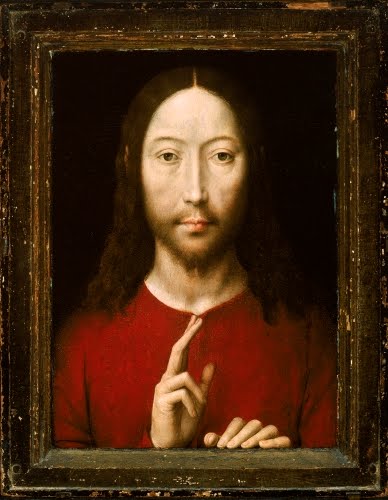 |
| Hans Memling (ca. 1430/1433–1494, born Germany, active Flanders), Christ Blessing, 1481. Oil on panel, 13 13/16" x 9 7/8" (35.1 x 25.1 cm). © Museum of Fine Arts, Boston. (MFAB-258) |
Correlations to Davis programs: Explorations in Art Grade 4” 2.studio7-8; Explorations in Art Grade 5: 5.29, 5.30; Explorations in Art Grade 6: 5.Connections; A Personal Journey: 4.4; A Community Connection: 1.1, 3.2; A Global Pursuit: 3.5, 4.5, 7.5; Discovering Art History: 4


Comments